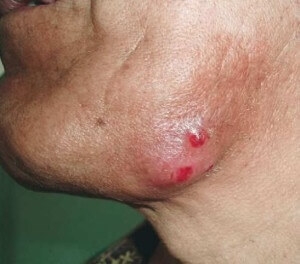Actinomycosis of the face is an extremely unpleasant and complex disease caused by actinomycetes – infectious pathogens, quite widespread in nature. You can pick them up anywhere – on many plants, soil, hay, they can live for a long time as a saprophytic flora on the mucous membranes (including the oral cavity), as well as in plaque, in the lacunae of the tonsils and do not cause any problems. But when an inflammatory process occurs, whether it is carious teeth, respiratory diseases or inflammation of the mucous membranes, actinomycosis can go into an active stage, especially if a staphylococcal infection joins the inflammation.
Actinomycosis of the face: causes of activation of the infection and signs of the disease
A granuloma appears at the site of actinomycetes penetration under the mucous membrane, which gradually grows into the surrounding tissues, and abscesses form in these granulations. When the purulent contents of abscesses break through, fistulas occur.
Most often, when taking an anamnesis, it turns out that the disease was preceded by tooth decay or the presence of long-term untreated caries, damage to the oral mucosa with sharp objects such as fish bones, ill-fitting prostheses or crowns, dry blades of grass, inflammatory gum disease, respiratory diseases.
The most common actinomycosis affects:
- tissue in the lower jaw area;
- cheeks;
- chin;
- jaw joint;
- neck;
- parotid area;
- language;
- lips.
Less commonly, the infection covers the ears, nasal septum, and the thyroid gland may be affected. There is damage to the bones and regional lymph nodes. If the inflammatory process is localized in the vicinity of the temporomandibular joint, the development of lockjaw of masticatory muscles is likely.
Characteristic signs suggestive of an actinomycosis infection
 Actinomycetes infect the face and neck, causing the formation of acute abscesses or severe forms of panniculitis. With this disease, inflammatory infiltrates of red or, conversely, very pale color can develop and form for a long time. Sometimes the manifestations of actinomycosis subside, but then flare up with renewed vigor. We can talk about the progression of the disease if the central purulent focus is scarred, but numerous abscesses and fistulas form nearby.
Actinomycetes infect the face and neck, causing the formation of acute abscesses or severe forms of panniculitis. With this disease, inflammatory infiltrates of red or, conversely, very pale color can develop and form for a long time. Sometimes the manifestations of actinomycosis subside, but then flare up with renewed vigor. We can talk about the progression of the disease if the central purulent focus is scarred, but numerous abscesses and fistulas form nearby.
The danger of actinomycosis lies in the probable penetration of actinomycetes into the cranial cavity, into the mediastinum or even into the blood vessels with the development of a general lesion of the body and an extremely poor prognosis.
Treatment of actinomycosis of the facial and cervical region
For complete healing of abscesses, incisions and drains alone are usually not enough, and specific antibiotic therapy is also required to prevent recurrence. The longer the manifestations of panniculitis and abscesses do not heal with actinomycosis, the higher the risk of progression of infiltrates in the periphery, the formation of fistulas and multi-chamber cavities in the affected tissues that respond poorly to antibiotics.
The best result is obtained by therapy with actinolysates in combination with antibiotics, the most effective drugs are tetracyclines, followed by phenoxymethylpenicillin. So far, resistance of actinomycetes to these groups of antibiotics has not been observed. If a secondary infection is superimposed, a long course of dicloxacillin or analogues of the same group is recommended.
Without timely etiotropic treatment, the prognosis for actinomycosis of the face and neck can be quite serious, with possible anatomical damage and severe relapses of the disease, so early and correct diagnosis of the disease is very important. To avoid recurrence, the patient must be under medical supervision for at least 6 months after recovery.







Add a comment